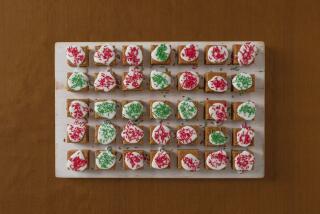Cookies: Set and Curl
- Share via
It takes careful timing and gentle persuasion to mold cookies into cylinders, tiles or edible containers. For best results, prepare only three or four cookies at a time.
Spoon the batter onto a greased and floured baking sheet (Step 1), leaving plenty of space for each cookie to spread. Bake them just until lacy and golden brown, watching carefully.
Remove and cool long enough so the delicate disks hold together when lifted with a spatula (Step 2) yet not so long that they become too crisp to mold. Two to three minutes is usually sufficient, but cooling time can vary depending on the type of baking sheet used and the temperature in the kitchen.
Finding the correct stage takes a little experimentation; do not get discouraged if the first few attempts aren’t a total success. (Even misshapen cookies taste delicious.)
Remove the warm cookies, one at a time, and begin rolling each around the buttered handle of a wooden spoon (Step 3). Continue shaping the cookies into cylinders, sometimes called “cigarettes” (Step 4). If the cookies harden too quickly, reheat briefly to soften.
Once cool, the cookies will retain their shape. Slip them off the spoon handle (Step 5) and continue cooling on a wire rack.
For added flavor and attractiveness, dip the ends of the cooled cookies in melted milk chocolate or dark chocolate (Step 6). Set the dipped cookies aside until the chocolate hardens.
Cylinder-shaped cookies may also be filled with flavored whipped cream. Add chocolate or liqueurs to the cream as it is whipped, then place in a pastry bag and, just before serving, quickly press the mixture into the cookies.
You can also curl the warm cookies into the shape of tiles by draping them over a rolling pin. Placing the still flexible disks in a metal baguette pan produces the same effect.
To make free-form edible containers for ice cream or sorbet, mousse, Bavarian cream or fresh fruit, prepare two cookies at a time using twice the amount of batter. Spread it into an even layer with a small spatula before baking.
Shape by draping the warm cookies over the bottom of an inverted drinking glass, coaxing the draped portions softly into a cup shape. This type of container can also be formed in muffin tins or custard cups.
Although crisp when freshly baked, the molded cookies may absorb moisture and soften during storage. Re-crisp in a warm oven just before serving.
CURLED ALMOND COOKIES 2/3 cup blanched almonds, ground 1/2 cup sugar 1 tablespoon flour 2 tablespoons milk 1/2 cup butter or margarine Melted milk chocolate or dark chocolate, optional
Combine almonds, sugar and flour in skillet. Stir in milk. Add butter and cook over low heat, stirring, just until butter melts and mixture is blended. Keep warm over very low heat.
Drop 1 tablespoon mixture at time onto greased and floured baking sheets. Place cookies at least 2 inches apart, 3 to 4 per sheet.
Bake at 350 degrees 5 minutes, until lacy and golden brown. Watch carefully to prevent overbrowning.
Remove cookies from oven and cool 2 to 3 minutes, until disks hold together when lifted with spatula. While still flexible, shape each cookie around buttered handle of wooden spoon. If cookies harden too quickly, reheat briefly to soften.
When cookies cool enough to hold shape, remove from spoon handle. Continue cooling on wire rack.
Dip ends of cooled cookies into melted chocolate. Set aside to firm before serving. Makes about 30 cookies.
Note: Do not store dipped cookies. If plain cookies soften during storage, place in single layer and reheat at 200 degrees 20 to 30 minutes.
More to Read
Eat your way across L.A.
Get our weekly Tasting Notes newsletter for reviews, news and more.
You may occasionally receive promotional content from the Los Angeles Times.








